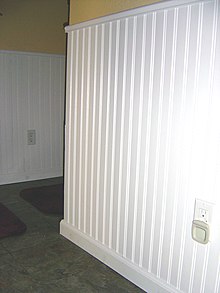Panelling(orpanelingin the United States) is amillworkwall covering constructed from rigid or semi-rigid components.[1]These are traditionally interlockingwood,but could beplasticor other materials.

Panelling was developed in antiquity to make rooms instonebuildings more comfortable both byinsulatingthe room from the stone and reflectingradiant heatfrom wood fires, making heat more evenly distributed in the room. In more modernbuildings,such panelling is often installed fordecorative purposes.Panelling, such as wainscoting and boiserie in particular, may be extremely ornate and is particularly associated with 17th and 18th centuryinterior design,Victorian architectureinBritain,and its international contemporaries.
Wainscot panelling
editThe termwainscot(UK:/ˈweɪnskət/WAYN-skətorUS:/ˈweɪnskɒt/WAYN-skot) originally applied to high qualityrivenoakboards.
Wainscot oak came from large, slow-grown forest trees, and produced boards that were knot-free, low intannin,light in weight, and easy to work with. It was preferred to home-grown oak, especially in the Netherlands and British Isles, because it was a far superior product and dimensionally stable.
TheOxford English Dictionarystates that it derives from theMiddle Low Germanwagenschotas well aswageschotor 'wall-board'.[2]Johnson's Dictionarydefined it thus:
Wainscot [wageschot,Dutch], the inner wooden covering of a wall.
To wainscot [waegenschotten,Dutch], to line the walls with boards
A 'wainscot' was therefore a board of riven (and laterquarter-sawn) oak, and wainscoting was the panelling made from it. During the 18th century, oak wainscot was almost entirely superseded for panelling in Europe by softwoods (mainlyScots pineandNorway spruce), but the name stuck:
The term wainscoting, as applied to the lining of walls, originated in a species of foreign oak of the same name, used for that purpose; and although that has long been superseded by the introduction offirtimber, the term has been continued notwithstanding the change of material.[3]
— Peter Nicholson,An Architectural Dictionary(1819)
Today the term wainscot refers commonly to the different treatment of the lower part of the wall (roughly a meter, 3–4 feet); see alsodado.
Boiserie
editBoiserie(French pronunciation:[bwazʁi];often used in the pluralboiseries) is the French term used to define ornate and intricately carved wood panelling.[4]Boiseriesbecame popular in the latter part of the 17th century inFrenchinterior design,becoming ade rigueurfeature of fashionable French interiors throughout the 18th century. Such panels were most often painted in two shades of a chosen color or in contrasting colors, with gilding reserved for the main reception rooms.[5]ThePalace of Versaillescontains many fine examples of white paintedboiserieswith gilded mouldings installed in the reigns ofLouis XVandLouis XVI.[6]The panels were not confined to just the walls of a room but were used to decorate doors, frames, cupboards, and shelves also. It was standard for mirrors to be installed and framed by the carvedboiseries,especially above the mantelpiece of a fireplace. Paintings were also installed withinboiseries,above doorways or set into central panels.[7]
Wood wall panelling
editWood wall panelling has seen a resurgence in popularity in recent years due to its aesthetic appeal, versatility, and sustainability. Traditionally used toinsulateand decorate interiors, modern wood panelling includes wainscoting, beadboard, shiplap, board and batten, and both raised and flat panels. This renewed interest is driven by the material's natural warmth and texture, its eco-friendly properties when sourced responsibly, and the influence of contemporary design trends showcased in media and online platforms.[citation needed]
See also
editReferences
edit- ^"Paneling".Encyclopædia Britannica.britannica.com.Retrieved11 January2016.
- ^"wainscot".Oxford Dictionaries.9 September 2017. Archived fromthe originalon September 9, 2017.
- ^Peter Nicholson,An Architectural Dictionary,2 Vols., London (1819).
- ^Garay, Regina (June 23, 2014)."The Beauty of Boiserie".paintandpattern.com.Retrieved11 January2016.
- ^Whitehead, John (1992).The French Interior in the 18th Century.Dutton Studio Books. pp. 95–7.
- ^Verlet, Pierre (1985). Le château de Versailles. Paris: Librairie Arthème Fayard
- ^Whitehead, John (1992).The French Interior in the 18th Century.Dutton Studio Books. pp. 95–7.
External links
edit- .Encyclopædia Britannica(11th ed.). 1911.